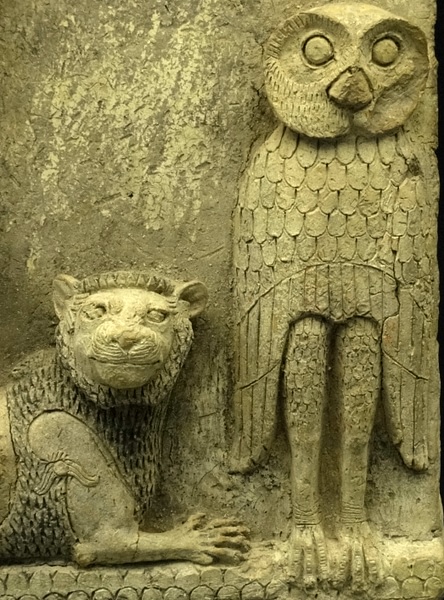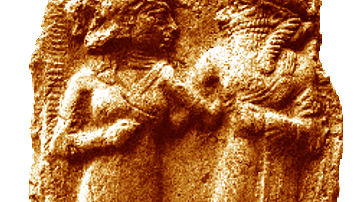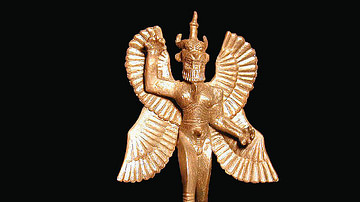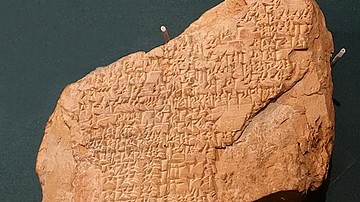The Queen of the Night (also known as the `Burney Relief') is a high relief terracotta plaque of baked clay, measuring 19.4 inches (49.5 cm) high, 14.5 inches (37 cm) wide, with a thickness of 1.8 inches (4.8 cm) depicting a naked winged woman flanked by owls and standing on the backs of two lions. It originated in southern Mesopotamia (modern day Iraq) most probably in Babylonia, during the reign of Hammurabi (1792-1750 BCE) as it shares qualities in craftsmanship and technique with the famous diorite stele of Hammurabi's laws and also with the piece known as `The god of Ur' from that same period.
The woman depicted in the relief is acknowledged to be a goddess as she wears the horned headdress of a deity and holds the sacred rod-and-ring symbol in her raised hands. Not only is the woman winged but her legs taper to bird talons (which seem to grip the lion's backs) and she is shown with a dew claw on her calves. Along the base of the plaque runs a motif which represents mountains, indicating high ground. Who the winged woman is, however, has not been agreed upon though scholars generally believe her to be either Inanna (Ishtar), Lilith, or Ereshkigal. The piece is presently part of the collection of the British Museum, Room 56, in London.
The Burney Relief's History
In 1936 CE the Burney Relief was featured in the Illustrated London News highlighting the collection of one Sydney Burney who purchased the plaque after the British Museum passed on the offer to buy it. Since the piece was not archaeologically excavated, but rather simply removed from Iraq sometime between the 1920's and 1930's CE, its origin and context are unknown. How the plaque arrived in London is also unknown, but it was in the possession of a Syrian antiquities dealer before coming to the attention of Sydney Burney.
Not much is known of Sydney Burney other than that he was a Captain in the English Army during WWI and was President of the Antique Dealers Association in London. The plaque was broken in three pieces and some fragments when originally purchased but, once repaired, was found to be mostly intact. The Burney Relief was analyzed in 1933 and authenticated in 1935 CE prior to the offer made to the British Museum. The plaque then changed hands twice before the British Museum finally acquired it in 2003 CE for the sum of 1,500,000 pounds, a considerably higher price than what was asked in 1935. It was at this time that the piece known as the Burney Relief came to be called `The Queen of the Night' due to the dark black pigment of the plaque's original background and the iconography (the downward pointing wings, the talon feet etc.) associating the female figure with the underworld. The name is therefore a modern, not an ancient, designation for the plaque. There is no way to know what the piece was originally called or what purpose it was created for.
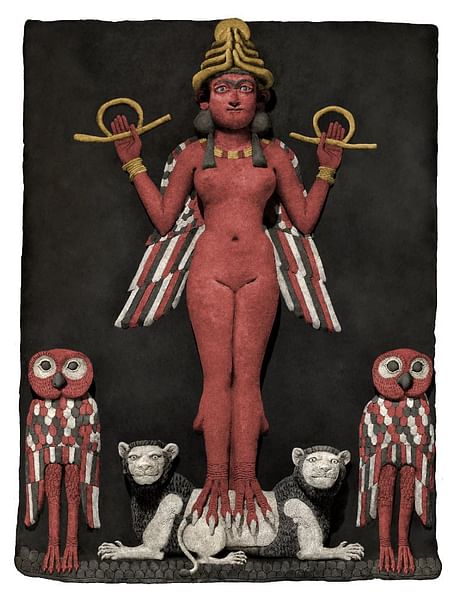
The Composition of the Relief
The relief was made of clay with chaff added to bind the material and prevent cracking. The fact that the piece was fired in an oven, and not sun dried, testifies to its importance as only the most significant works of art and architecture were created in this way. Since timber was scarce in southern Mesopotamia, it was not used lightly for firing clay objects. According to Dr. Dominique Collon of the British Museum the plaque was made by
...clay pressed into a mould and allowed to dry in the sun…the figure was made from fairly stiff clay which was folded and pushed into a specially shaped mould, with more clay added and pressed in behind to form the plaque. Thus the Queen's figure is an integral part of the plaque and was not added to it later. After drying, the plaque was removed from the mould, the details were carved into the leather-hard clay and the surface was smoothed. This smoothed surface is still visible in certain places, notably near the Queen's navel…The edges of the plaque were trimmed with a knife. Then the plaque was baked. (15)
Once the piece was done baking and had cooled, it was painted with a black background, the woman and the owls in red, and lions in white with black manes. The rod-and-ring symbols, the woman's necklace, and her headdress were gold. The original color traces may still be detected on the piece today even though they have largely worn away over the centuries.
Origins & Placement
While it may never be known exactly where the piece was made, for what purpose, or which goddess it represents, the similarities in technique between it and the so-called `God of Ur', are so striking that it has been speculated that the Sumerian city of Ur is its place of origin. Dr. Collon notes:
The god from Ur is so close the Queen of the Night in quality, workmanship and iconographical details that it could well have come from the same workshop, perhaps at Ur, where extensive remains of the Old Babylonian period were excavated between 1922 and 1934. (20)
The individual who originally removed the plaque, then, could have been a member of one of the excavating teams during that time or simply someone who came upon the piece once it was uncovered.
Theories as to its original placement and significance have been suggested by every scholar who has studied it. As sacred prostitution was practiced throughout Mesopotamia, the historian Thorkild Jacobsen believed that the plaque formed a part of a shrine in a brothel. Dr. Collon notes, however, that “if this were so, it must have been a very high-class establishment, as demonstrated by the exceptional quality of the piece” (22). She further theorizes that the plaque would have been hung on a wall of mud brick, probably in an enclosure, and that, when the mud brick wall collapsed, the fired terracotta plaque would have remained relatively intact. The fact that the piece has survived for over 3000 years attests to its having been buried fairly early after the building which housed it fell or was abandoned because it was thereby protected from the elements and from vandalism.
The Identity of the Queen of the Night
The identity of the Queen is the most intriguing aspect of the piece and, as noted above, three candidates have been proposed: Inanna, Lilith, and Ereshkigal. The nude woman motif was popular throughout Mesopotamia. The historian Jeremy Black notes:
Hand-made clay figurines of nude females appear in Mesopotamia in prehistoric times; they have applied and painted features. Figurines of nude women impressed from a pottery or stone mould first appear at the beginning of the second millennium BC…It is very unlikely that they represent a universal mother goddess, although they may have been intended to promote fertility. (144)
Inanna would be the goddess in keeping with a plaque encouraging fertility as she presided over love and sex (and also war) but there are a number of problems with this identification.
Inanna
If one accepts the findings of Dr. Black and others who agree with him, then that poses a problem with Inanna as Queen of the Night since she was not universally regarded as a mother goddess in the way that Ninhursag (also known as Ninhursaga) was. Ninhursag was the mother of the gods and was regarded by the people as the great mother goddess. There are also problems with Inanna as the Queen stemming from the iconography of the piece. While Inanna is associated with lions, she is not linked with owls. The headdress and the rod-and-ring symbols would fit with Inanna, as would the necklace, but not the wings or the talon-feet and dew claw. The scholar Thorkild Jacobsen, arguing for Inanna as the Queen, presents four aspects of the plaque which point to the Queen's identity:
- Lions are an attribute of Inanna.
- The mountains beneath the lions are a reflection of the fact that Inanna' s original home was on the mountaintops to the east of Mesopotamia.
- Inanna took the rod-and-ring with her in her descent to the underworld and her necklace identified her as a harlot.
- Her wings, bird talons and owls show that Inanna is pictured in her aspect of Owl goddess and goddess of harlots.
Dr. Collon, however, dismisses these claims pointing out that Inanna “is associated with one lion, not two” and the point regarding the rod-and-ring symbol and necklace can be discounted as they “could have been worn or held by any goddess” (42). Dr. Collon also points out that the “first published photograph of the Queen of the Night relief in 1936 read: `Ishtar…the Sumerian goddess of love, whose supporting owls present a problem'” (43). Ishtar was the later name for Inanna and, while owls have been mentioned in tales concerning the goddess, they were never a part of her iconography. Further, Inanna is never depicted frontally in any ancient art but, always, in profile and the mountain range at the bottom of the plaque could argue as well for identification with Ereshkigal or Lilith.
Lilith
Lilith is a demon, not a goddess, and although there is some association of the Lilith demon with owls, they are not the same kind of owls that appear on the relief. Further, Lilith comes from the Hebrew tradition, not the Mesopotamian, and corresponds only to the Mesopotamian female demons known as lilitu. The lilitu and the so-called ardat lili demons were especially dangerous to men whom they would seduce and destroy. The male demons of this sort, the lilu, preyed on women and were an especial threat to those who were pregnant or had just given birth and also to infants. The article, The Burney Relief: Inanna, Ishtar, or Lilith? states why the Lilith identification is a probability:
Rafael Patai (The Hebrew Goddess 3rd ed. 1990) relates that in the Sumerian poem Gilgamesh and the Huluppu Tree, a she-demon named Lilith built her house in the Huluppu tree on the banks of the Euphrates before being routed by Gilgamesh. Patai then describes the Burney plaque: “A Babylonian terra-cotta relief, roughly contemporary with the above poem, shows in what form Lilith was believed to appear to human eyes. She is slender, well-shaped, beautiful and nude, with wings and owl-feet. She stands erect on two reclining lions which are turned away from each other and are flanked by owls. On her head she wears a cap embellished by several pairs of horns. In her hands she holds a ring and rod combination. Evidently this is no longer a lowly she-demon, but a goddess who tames wild beasts and, as shown by the owls on the reliefs, rules by night.
Even so, the possibility that the Queen of the Night plaque, with its high degree of skill in craftsmanship and attention to detail would be a representation of a lilitu is highly unlikely. According to the Hebrew tradition, Lilith was the first woman made by God who refused to submit to Adam's sexual demands and flew away, thus rebelling against God and his plans for human beings. She was thought to have then occupied the wastelands and, like the lilitu, to have preyed on unsuspecting men ever since. In either tradition, the lilitu was not a popular enough figure to have been portrayed on a plaque such as the Queen of the Night. Dr. Black notes, “Evil gods and demons are only very rarely depicted in art, perhaps because it was thought that their images might endanger people” (62). The mountain range depicted at the bottom of the relief is also thought to suggest lilitu identification in representing the wilderness the spirit inhabits but the headdress, the necklace, the rod-and-ring symbols and the significance of the plaque all go to argue against Lilith as a possibility.
Ereshkigal
The third contender is Inanna's older sister, Ereshkigal, the Queen of the Great Below. Her name means “Lady of the Great Place” referring to the land of the dead and there are a number of aspects of the plaque which seem to suggest Ereshkigal as the best candidate for Queen. The motif of the downward pointing wings was used throughout Mesopotamia to indicate a deity or spirit-being associated with the underworld and the Queen has such wings. Ereshkigal lived in the underworld palace of Ganzir, thought to be located in the eastern mountains, which would account for the mountain range depicted running along the bottom of the plaque. Regarding Ganzir and the underworld, Dr. Collon writes, “It was a dark place and the dead, naked or clothed with wings like birds, wandered with nothing to drink and only dust to eat. Whatever they had achieved in life, the only sentence was death, pronounced by Ereshkigal” (44).
Ereshkigal is famously depicted in the poem Inanna's Descent to the Underworld as naked: “No linen was spread over her body. Her breasts were uncovered. Her hair swirled around her head like leeks” (Wolkstein and Kramer, 65) and the Queen on the plaque is nude. Further, unlike depictions of Inanna in profile, the Queen is shown from the front. Dr. Collon writes:
As a goddess, Ereshkigal was entitled to the horned headdress and the rod-and-ring symbol. Her frontality is static and immutable and, as Queen of the Underworld where `fates were determined', hers was the ultimate judgment: she might well have been entitled to two rod-and-ring symbols. (44)
In this same way the lions the Queen stands on could represent Ereshkigal' s supremacy over even the mightiest of living things and the owls, with their association with darkness, could be linked to the land of the dead. All of the iconography of the Queen of the Night plaque seems to indicate the deity represented is Ereshkigal but, as Dr. Collon states, “no definite connection with Ereshkigal can be made as she has no known iconography: her association with death made her an unpopular subject” (45). With no known iconography of Ereshkigal to compare the Queen of the Night with, the identity of the Queen remains a mystery.


